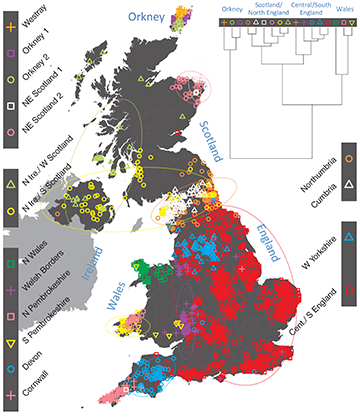The People of the British Isles (PoBI) project was initiated by Sir Walter Bodmer in 2004, in an effort to create the first ever detailed genetic map of a country. The United Kingdom’s history bristles with immigrations, wars and invasions, so the PoBI researchers faced a tremendous task in investigating how past events impacted the genetic makeup of modern British people.
We recruited volunteers whose four grandparents were born in rural areas of Britain, within 50 miles from one another. We collected blood samples as a source of DNA for our genetic studies. Since our DNA is really a mixture of our ancestors’ DNA we could use it to look back in time and study the ancestry over centuries past. A subset of our samples (2039) was extensively analysed, and the groundbreaking results were published in Nature on the 19th of March 2015 (see Population Genetics). Results included a map (image below) showing a remarkable concordance between genetic and geographical clustering of our samples across the United Kingdom. The analyses were developed even further and showed relationships of the UK genetic clusters to the genetics of surrounding European groups (see Population Genetics for detailed information).

Genetic clustering of British population.